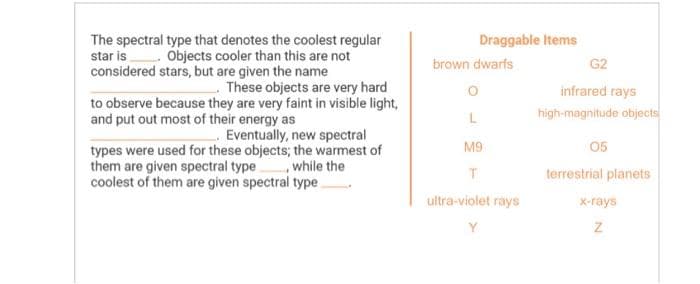The spectral type that denotes the coolest regular star is. Objects cooler than this are not considered stars, but are given the name These objects are very hard to observe because they are very faint in visible light, and put out most of their energy as Eventually, new spectral types were used for these objects; the warmest of them are given spectral type, while the coolest of them are given spectral type Draggable Items brown dwarfs M9 T ultra-violet rays G2 infrared rays high-magnitude objects 05 terrestrial planets x-rays Z
The spectral type that denotes the coolest regular star is. Objects cooler than this are not considered stars, but are given the name These objects are very hard to observe because they are very faint in visible light, and put out most of their energy as Eventually, new spectral types were used for these objects; the warmest of them are given spectral type, while the coolest of them are given spectral type Draggable Items brown dwarfs M9 T ultra-violet rays G2 infrared rays high-magnitude objects 05 terrestrial planets x-rays Z
Introductory Chemistry: A Foundation
9th Edition
ISBN:9781337399425
Author:Steven S. Zumdahl, Donald J. DeCoste
Publisher:Steven S. Zumdahl, Donald J. DeCoste
Chapter11: Modern Atomic Theory
Section: Chapter Questions
Problem 14ALQ
Related questions
Question
Answer it correctly please. I will rate accordingly with multiple votes. This is my last attempt. Please do it correctly.

Transcribed Image Text:The spectral type that denotes the coolest regular
star is. Objects cooler than this are not
considered stars, but are given the name
These objects are very hard
to observe because they are very faint in visible light,
and put out most of their energy as
Eventually, new spectral
types were used for these objects; the warmest of
them are given spectral type, while the
coolest of them are given spectral type
Draggable Items
brown dwarfs
L
M9
T
ultra-violet rays
Y
G2
infrared rays
high-magnitude objects
05
terrestrial planets
x-rays
Z
Expert Solution
This question has been solved!
Explore an expertly crafted, step-by-step solution for a thorough understanding of key concepts.
This is a popular solution!
Trending now
This is a popular solution!
Step by step
Solved in 2 steps

Knowledge Booster
Learn more about
Need a deep-dive on the concept behind this application? Look no further. Learn more about this topic, chemistry and related others by exploring similar questions and additional content below.Recommended textbooks for you

Introductory Chemistry: A Foundation
Chemistry
ISBN:
9781337399425
Author:
Steven S. Zumdahl, Donald J. DeCoste
Publisher:
Cengage Learning

Chemistry
Chemistry
ISBN:
9781305957404
Author:
Steven S. Zumdahl, Susan A. Zumdahl, Donald J. DeCoste
Publisher:
Cengage Learning

Chemistry & Chemical Reactivity
Chemistry
ISBN:
9781133949640
Author:
John C. Kotz, Paul M. Treichel, John Townsend, David Treichel
Publisher:
Cengage Learning

Introductory Chemistry: A Foundation
Chemistry
ISBN:
9781337399425
Author:
Steven S. Zumdahl, Donald J. DeCoste
Publisher:
Cengage Learning

Chemistry
Chemistry
ISBN:
9781305957404
Author:
Steven S. Zumdahl, Susan A. Zumdahl, Donald J. DeCoste
Publisher:
Cengage Learning

Chemistry & Chemical Reactivity
Chemistry
ISBN:
9781133949640
Author:
John C. Kotz, Paul M. Treichel, John Townsend, David Treichel
Publisher:
Cengage Learning

Chemistry & Chemical Reactivity
Chemistry
ISBN:
9781337399074
Author:
John C. Kotz, Paul M. Treichel, John Townsend, David Treichel
Publisher:
Cengage Learning

Chemistry: The Molecular Science
Chemistry
ISBN:
9781285199047
Author:
John W. Moore, Conrad L. Stanitski
Publisher:
Cengage Learning

Chemistry: Principles and Reactions
Chemistry
ISBN:
9781305079373
Author:
William L. Masterton, Cecile N. Hurley
Publisher:
Cengage Learning